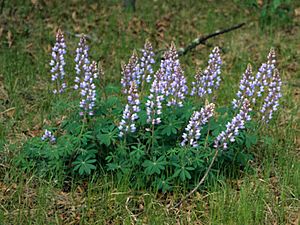Lupine facts for kids
The word Lupine is an interesting term that can describe a few different things! When you hear "lupine," it might make you think of a wild animal, or perhaps a colorful garden plant. It's a word that helps us connect ideas to something specific, depending on the context. Let's explore the main meanings of "lupine" and learn more about them.
Contents
What Does 'Lupine' Mean?
The word "lupine" comes from the Latin word lupinus, which means "of or pertaining to a wolf." This gives us a big clue about one of its main uses! However, it also refers to a whole group of beautiful flowering plants. Understanding the context helps us know which meaning is being used.
Lupine and Wolves
When something is described as "lupine," it often means it has qualities similar to a wolf. Wolves are fascinating wild animals known for their intelligence, strength, and social behavior. They live in packs and communicate using howls, barks, and body language. Thinking of "lupine" in this way helps us imagine traits like being wild, strong, or even having a certain kind of independence.
Wolf Characteristics
Wolves are apex predators, meaning they are at the top of their food chain. They have keen senses, including excellent hearing and a powerful sense of smell, which help them hunt. Their fur can be various shades of gray, brown, white, or black, helping them blend into their natural environments. Wolves are also known for their loyalty within their pack, working together to raise their young and find food.
The Beautiful Lupine Plant
Another very common meaning for "lupine" refers to a genus of flowering plants called Lupinus. These plants are famous for their tall, colorful flower spikes that can be seen in gardens and wild meadows around the world. They belong to the pea family, Fabaceae, and are known for their unique seed pods.
What are Lupine Plants?
Lupine plants come in many different sizes and colors. Their flowers grow in tall, cone-shaped clusters, often displaying shades of blue, purple, pink, yellow, and white. The leaves are usually palmate, meaning they look like a hand with several leaflets spreading out from a central point. These plants are not just pretty; they also play an important role in nature.
Where Do Lupines Grow?
Lupines are found in many parts of the world, including North and South America, Europe, and Africa. They are very adaptable and can grow in different environments, from coastal areas to mountains. Many species prefer sunny spots with well-drained soil. In some places, like the Pacific Northwest of the United States, wild lupines create stunning fields of color during spring and summer.
Life Cycle of a Lupine
Lupine plants typically start their life as a seed. Once the seed germinates, it grows into a seedling, developing roots and leaves. As the plant matures, it produces its distinctive flower spikes. After the flowers are pollinated, they develop into seed pods. These pods contain the new seeds, which will eventually fall to the ground, ready to start the cycle again. Some lupine species are annuals, meaning they complete their life cycle in one year, while others are perennials, returning year after year.


